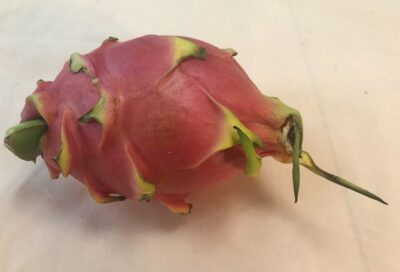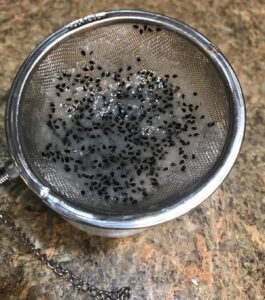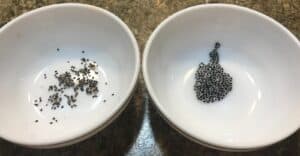This post contains affiliate links.
I always like to experiment with new ideas and after buying a dragon fruit at my grocery store one day, I wondered if it was possible to grow a dragon fruit cactus from a store-bought dragon fruit. I have successfully grown other types of plants from store-bought vegetables and fruit, so I was confident that I could do the same with dragon fruit. I also wanted to see what others have done and what methods they used to germinate the seeds. So after a search with the question “Can you grow dragon fruit from store-bought fruit “ I had my answer.
To grow a dragon fruit cactus from store-bought fruit, just scoop out some of the fruit, place it in a strainer, and rinse off the pulp. Allow the seeds to dry then plant them in a cactus potting soil mix. Cover the pot with plastic to keep the soil moist until the seedlings start to sprout.
First, Here’s Some Information About Dragon Fruit

Dragon fruit, Hylocereus undatus, is also known as pitaya. It is a climbing (and vining) cactus that originates from Mexico, Central and South America. There are different species of this cactus, all of which produce fruit. They are now cultivated in many other parts of the world such as Southeast Asia, Australia, and the United States.
Dragon fruit is gaining in popularity in this country; you can often find the fruit for sale in local grocery stores in the produce section. But even more than that, you can find dragon fruit juice sold as a popular refreshing drink at Starbucks or other fast food stores, and even bottled and sold in your grocery stores.
The fruits of these cactus plants are oval-shaped and come in different colors. The skin is leathery and smooth. Bright red is probably the most common color found in our grocery stores, but the skin of these fruits can also be pink or even yellow depending on the type.
The inside of these fruits are usually white with small black seeds, but in other types the fruit can also be red. The fruit itself is juicy (similar to the juiciness of watermelon) – and the flesh can be easily scooped out as you would watermelon or other melons.
Their taste has been described in different ways… but to me, the taste is similar to that of a kiwi but with a more subtle and milder flavor.

I think that dragon fruit would go well served mixed in with other fruit such as mangos, or berries. I’ve found that they need to be served soon after scooping them out of their skins since the fruit tends to get watery after sitting too long, but that isn’t a problem if you are serving it as juice.
The plant itself is a vining and climbing cactus that can grow quite tall (about 20 feet or more) in its natural environment.
When grown indoors it is much smaller, Some sources say that at the most it could reach 6-8 feet in height. Since these plants can grow quite large they are usually supported with a trellis.
These trellis’ need to be sturdy to support the plant. Amazon has only a couple of them that I could find that are made specifically for supporting dragon fruit. One of them can be found here, and the other one here.
How big the plant gets depends on the size of the pot it is grown in and whether you prune it down to a smaller size or not. With proper care, you can keep your dragon fruit cactus plant healthy and fruitful on a much smaller scale for your indoor garden.
This isn’t what you would consider a “typical” cactus; since it thrives in more humid conditions than other types of cacti. This is because it is a subtropical cactus.
If you are interested in learning more about the different types of dragon fruit, check out our other article.
How to Grow Dragon Fruit From Your Store-Bought Fruit
Many grocery stores sell dragon fruit as a “specialty” or “exotic” fruit in their produce section. They cost more than other fruit probably because they aren’t that common, and that is one reason why I wanted to see if I could grow one in my home. The other reason was that I knew I would enjoy the process.
🌵 Once you have chosen your fruit, cut it open and scoop out the flesh. Since there are a lot of seeds, you can eat and enjoy most of the fruit and still have enough left over for your seed collection process.
🌵 To collect seeds, just rinse off the pulp in a very small-meshed strainer or sieve. I use a large tea strainer so I don’t wash away all the seeds; if I use anything larger, the seeds will wash away since they are very small.

🌵 Spread the seeds on a paper towel to dry for a day or two. It doesn’t matter if some of the pulp is still sticking to the seeds. It will dry up along with the seeds and you can crumble most of it away when you remove the seeds from the paper towel.

🌵 Prepare pots by filling them with a quickly draining soil suitable for succulents or cactus plants, but more specifically, one for tropical cactus plants.
This would be similar to the type of soil that Christmas and Easter cacti need. This type of soil should be well-aerated, but also contain more organic materials than your usual cactus soil.
We show you how to make your own cactus soil in our other article. In it, we include a recipe for tropical cactus soil – which is what you would need for dragon fruit.
If you want to buy your cactus soil, then Amazon has some that I have used and recommend. Miracle-gro is one of those. It is a heavier soil than I would like for my desert cactus plants (unless I amend it with sand or perlite), but I’ve found it suitable for propagating and for tropical cactus plants. I also like it because it is economical. I always add perlite to this soil to give it more aeration and even with the added cost of the perlite, it is still economical.
🌵 Make sure the soil is damp, but not waterlogged. You want to keep the soil moist during the germination period, but not too wet either since cactus plants are susceptible to rot when their roots are wet for too long.
🌵 Place the seeds on the soil surface, and lightly stir them into the top 1/4th inch of the soil. If the seeds have been drying too long, you could wet or soak them right before planting to speed up the germination process.
🌵 You may either cover the pot with plastic wrap to keep the moisture in, or alternately, mist the soil daily until the seeds have germinated.
🌵 It will take about 1-3 weeks for the seeds to germinate. When they do, give them plenty of light. Keep them in the sunniest location in your home, or supplement light by using an LED plant light.
I need to supplement light for my plants since there isn’t enough light in my home and I use full-spectrum LED lights similar to these ones on Amazon.
🌵 When the seedlings have grown a few new leaves, it is time to transplant them into their own pots.
By following these steps you will not only collect seeds from your store-bought dragon fruit, but you will also be able to grow your own dragon fruit plants from these seeds.
Eventually, given time and the correct conditions, these cactus plants could flower and produce your own home-grown fruit.
If you are interested in other types of cacti that produce edible fruit you can learn about some of them here.
How Long Does it Take for Dragon Fruit Seeds to Germinate?

Dragon fruit seeds germinate fairly quickly. The time can vary depending on whether the seeds are fresh or dried. Fresh, undried seeds can take just a few days to about a week while dried seeds can take between one to four weeks.
You can speed up the germination of dried seeds by wetting or soaking them (for a short period of time) before planting them in the soil.
How Long Does it Take for Dragon Fruit to Bear Fruit?
If your container-grown dragon fruit was propagated from a seed, it may take up to 7 years before it is mature enough to bear fruit. It can take 1-3 years for those propagated from cuttings.
Dragon fruit cactus plants will bear fruit only when the plant is fully mature.
It takes longer to reach for the plant to reach maturity when it is propagated from seed than if it is propagated by cuttings. It also takes longer when it’s grown in a container than if it is grown outdoors.
Here’s a table with a few facts about dragon fruit cactus plant:
| Fact | Information |
| Scientific Name | Hylocereus undatus |
| Size in Natural Environment | Varies; it can reach up to 20 feet (6 meters) or more |
| Size in Containers | Varies; can be kept compact with regular pruning |
| Sun Requirements | Full sun to partial shade |
| Soil | Well-draining soil |
| Blooming Season | Typically during spring and summer |
| Frequency of Blooms | Multiple times per year |
| Native Area | Central and South America, Mexico |
| Flower Color | Varies: White, pink, red, or yellow |
| Fruit Color | skin is redFlesh is white with small black seeds |
This information is general and the specifics may vary some.
Further Information:
This video gives you an alternate way to propagate your dragon fruit seed– by placing them in water until they sprout. It also gives you a good idea of how much they can grow in one year.
This post was written for cactus-central.com and is not permitted to be used on other sites.

